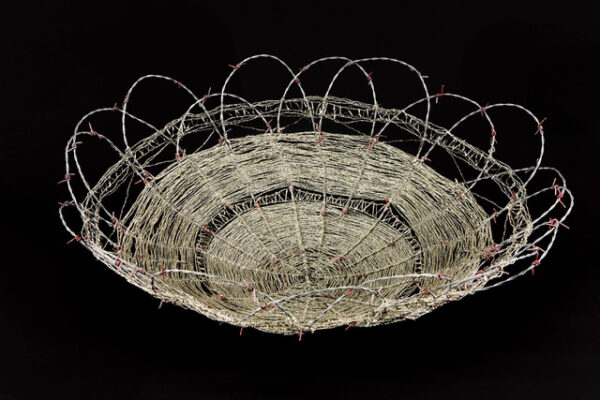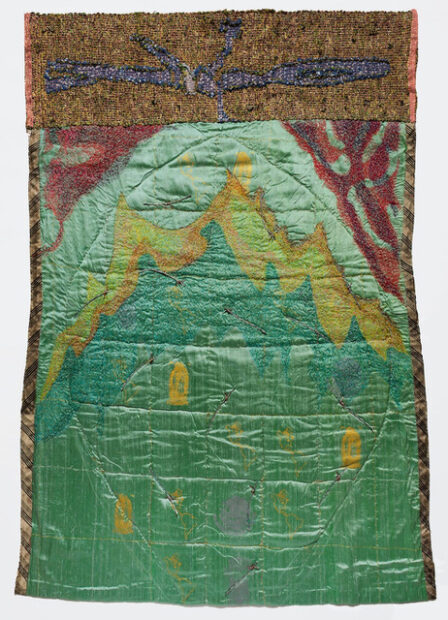Para leer este artículo en español, por favor vaya aquí. To read this article in Spanish, please go here.

Consuelo Jimenez Underwood, “Mi Oro, Tu Amor,” 1994, painted, wrapped, embroidered, stitched cotton canvas, silk fabric, barbed wire, gold wire, paint, corn, and bean kernels. 48 x 51 inches
In One Nation Underground, on view at Ruiz-Healy Art in San Antonio, fiber artist Consuelo Jimenez Underwood weaves an American narrative bigger than its borders, right down to the details. Combining traditional loom techniques with contemporary materials (yellow caution tape, barbed wire, safety pins), Jimenez Underwood’s conceptual textiles speak to what the artist calls an “alarm system going off in the borderlands.” From small tapestries to wall-sized installations, every fiber in her work helps sound the alarm.
Jimenez Underwood grew up in a family of migrant farmworkers in California, and experienced firsthand the inextricable ties between the United States, Mexico, and the Indigenous presence on the land that far precedes both. Often using wry humor (as evidenced by the exhibition title, based on a large-scale U.S and Mexican flag the artist has sewn together), she is quick to point out how policies continue to enable and ignore issues along the border. As a young girl, Jimenez Underwood watched her own father, who was undocumented at the time, undergo deportation on numerous occasions, only to reunite with the family and resume working in the farm fields in California. Throughout the show, references to undocumented people, plants, even objects, reflect on what it means to exist on both sides of a border.
In Mi Or, Tu Amor (1994), an antiquated map of Mexico stretches up to what is now Northern California before sloping southeast, as far as Louisiana, and down through Central America. Translating to “My Gold, Your Love,” the colonial map is confined by strands of barbed wire, wrapped in gold wire. Look even closer and you will see kernels and seeds sewn into place. Jimenez Underwood notes that New Spain supplied Europe with enough gold to fund the Renaissance, but the map’s most subtle detail suggests it takes something much smaller, much simpler to sustain an empire.

Consuelo Jimenez Underwood, “American Foods: Corn, Bean, Squash,” 2019, fiber, mixed media, woven, 19 x 45 inches each
Food is a recurrent element in these works, both as a cultural connector and humble reminder of our most basic necessity. In American Foods: Corn, Bean, Squash (2019), Jimenez Underwood spotlights tres hermanas — the “three sisters” — a cornerstone of the American Indian diet for centuries that, when planted together, support and protect one another for optimal growth. From afar, the three woven textiles possess a certain burlap toughness, complete with a barbed wire design embedded in their pattern. But up close, hundreds of little details quickly reveal themselves: metallic floss and leather cord, colorful beads and an impressive fringe of safety pins. All three panels, horizontal in their layout, contain a vertical break about halfway through, dramatically cleaved yet tenuously connected by safety pins.
“She loves these pins because it’s about fragility. Our fragility,” gallery owner Patricia Ruiz-Healy points out as we admire the trio just prior to install. Perhaps the panels’ most interesting attribute is the one that remains unseen: on the back of each, a bright cotton pattern that has no aesthetic bearing on the work’s outward appearance. A blue spotted print for Corn, purple dragonflies for Bean, a red floral design for Squash. Why? Just because, says Ruiz-Healy with a little smile: “She loves to decorate, she loves to make things happy.”

Consuelo Jimenez Underwood, “Undocumented Tortilla Basket,” 2008, barbed wired, aluminum and steel wire, 9 x 29 inches diameter.
Jimenez Underwood started out as a painter before shifting her practice to the textile-based traditions of her Chicana and Huichol heritage. Much like painting, her woven works are a declaration of color, with each one telling a story of dueling beauty and darkness. Softness offsets hardship in these stories, while continually returning to the theme of in-between.
In Undocumented Tortilla Basket (2008) — the show’s only freestanding sculpture — an oversized basket constructed from barbed wire creates a clear visual dissonance. Each sharp twist of steel has been painted red, and despite the object’s elegant craftsmanship, its brutality is hard to get away from. Then there is Undocumented Nopal. 2525 A.D. (2019), a silk dress that features the cactus leaf’s faint quilted outline. Tiny silkscreened maps of the Americas and praying silhouettes of syncretic Virgins appear throughout, as bits of barbed wire suture the sacred symbols and native species into place. The fate of this undocumented nopal — set far off in the future — rests in its quiet resilience.

Consuelo Jimenez Underwood, “Undocumented Nopal. 2525 AD,” 2019, stitched, woven, embroidered, silkscreened. Silk and cotton fabric. Linen, Kentucky barbed wire, cotton and synthetic thread. 70 x 48 inches.
“Beauty, grace, and flowers soothe the quiet rage that has permeated the Americas for more than five hundred years,” Jimenez Underwood writes in her artist statement — words that ring clear as I stand before her Border Flowers Flag (2008). The tricornered tapestry, iconically red, white, and blue, features state flowers for stars, and strips of tortilla cloths for stripes. Its three corners are reminiscent of the three sisters, and of the border’s three cultures; the way they remain inextricably connected.
Now in her seventies, Jimenez Underwood lives and works in Northern California, a few hours up the coast from where she taught for 20 years at San Jose State University. It is a busy time for her: this past spring, she was awarded a Latinx Artist Fellowship from the Ford and Mellon Foundations, which recognizes 15 notable Latinx visual artists working in the U.S. today. And One Nation Underground is running concurrently with her other solo show, Threads from Border-Landia, at Ruiz-Healy Art’s New York City location.
I ask the gallery’s owner if there were any pieces for the San Antonio show that were also considered for New York. She points to a small red, white, and blue flag titled Guns and Stripes (2008), where, once again, the stars have been swapped out. “Consuelo felt this one should be in New York, but I felt it was more a Texas work,” she says as we both gaze at its white woven handguns. “Interestingly enough, a museum in New York has put it on hold.”
One Nation Underground is on view through January 28, 2023 at Ruiz-Healy Art in San Antonio.


